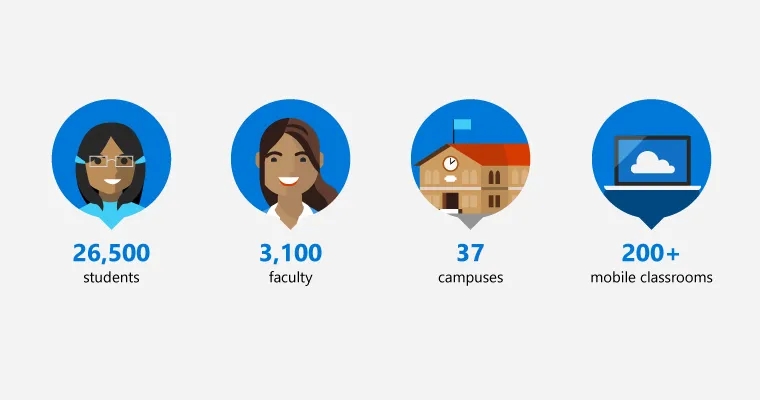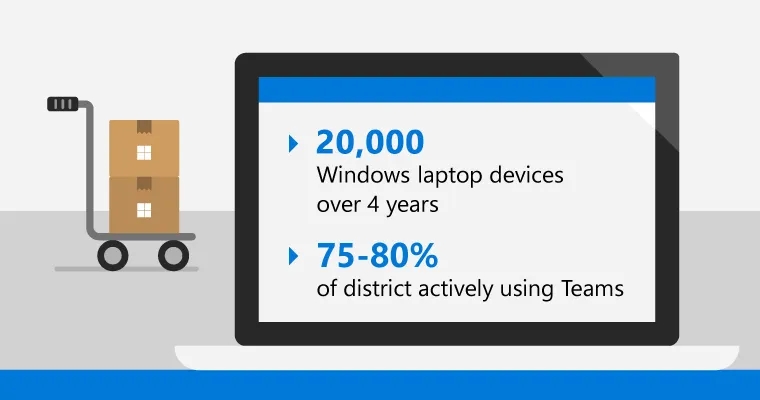
How Onslow County engages students with Windows 10 and Office 365
| Focus on: Empower students, Empower educators, Transform learning |
Few public school districts in North Carolina have a growth rate as consistent as Onslow County Public Schools. In 2017 alone, the district welcomed 26,500 students and 3,100 staff members. For the last three decades, Onslow County has grown its student population by approximately 300 students annually.[1] Their faculty population has also expanded by 30-40 new teachers each year.
In addition to 37 school campuses, Onslow County’s increasing population requires more than 200 mobile classrooms and the district has plans to build another two elementary schools soon.[2] With two military bases in its boundaries and several others scattered nearby, Onslow County Public Schools manages a somewhat unpredictable community of learners and educators.

Building an in-house team to drive digital transformation
Onslow County’s leadership understands the value of digital innovation. The district has garnered a reputation for being especially progressive and open to new digital opportunities, consistently demonstrating a commitment to transforming learning with the latest technologies.
Onslow County Schools employs a team of technology-focused staff, headed by Jeff Pittman, Chief Technology Officer. The Instructional Technology Division is comprised of 24 computer technicians, and a 17-person IT team at the county’s headquarters. Ross G. Friebel, Director of Digital Learning and Teaching, also manages 21 Instructional Technology Facilitators responsible for integrating technology into the K-12 curriculum. Together, Pittman, Friebel, and Stephen Taylor, Coordinator of Digital Learning and Teaching, have managed the district’s multi-year digital transformation.
Implementing innovation to complement a progressive school district
Onslow’s transformation journey began in the mid-2000’s with a pilot version of the 1:1 program. Typically, these programs provide students with their own mobile devices; but Onslow’s pilot stage focused on educators. Teachers were encouraged to participate through a grant-based application system, specify how many devices they needed, and demonstrate how they’d be used to transform learning. The program’s success prompted the Onslow County Board of Education and the County Commissioners to develop an annual funding solution to support the district’s continued transformation.
From this point, Onslow’s implementation strategy was completed in three stages:
- In 2006, the district provided every faculty member with a Windows laptop
- Soon after, various classroom technologies were implemented across the district as an introductory opportunity for students to explore innovation
- In 2012, the district began the multi-year roll-out of their 1:1 program, providing Windows devices for students

Onslow County’s technology team facilitated the district-wide transformation with extensive pre-planning. For educators, they offered technical support and training sessions on professional development and classroom management. They organized additional annual workshops for new and existing hires.
The district’s technology teams also hosted proactive “Parent Night” events and other informal orientation sessions. When the 1:1 program first launched, Friebel and Taylor found themselves fielding questions from parents and school principals every week. Now, four years later, things have changed.
“This year, we’ve hardly had any calls at all,” Taylor confirmed. “We used a lot of preemptive communication, and now the program has become an assumed practice here at Onslow County.”
Friebel’s team was also instrumental to the implementation process. Focused on supporting the educators’ specific teaching goals, they helped teachers integrate new technology directly into their lessons to effectively transform learning in the classroom.
Exploring the success of the Windows 1:1 program and Office 365 Suite adoption
To date, Onslow County’s 1:1 program has deployed approximately 20,000 Windows laptop devices throughout the district. Like their broader digital transformation process, they completed their Windows 10 adoption in four stages:
- In 2012-2013, Windows laptops were implemented in grades seven through nine
- In 2013-2014, the program was expanded to fifth and tenth grades
- In 2014-2015, it added grades fourth, sixth, and eleventh
- In 2015-2016, third and twelfth grades were included

Along with laptops, students were given individual Office 365 accounts. At one point, the district considered leveraging a Google-based digital environment for their students. But according to Pittman, who experienced Google’s digital solutions and Chromebook devices firsthand at a previous district, Microsoft’s offerings were a better fit.
“Having worked entirely with Chromebooks in the past, and now working entirely with Office 365, I really feel Microsoft’s platform better prepares our students for success at Onslow County, and for life beyond high school,” Pittman explained. “The reality is, when they get out in the workforce, they’re probably going to be working on the same type of devices they’re using now.”
Office 365’s innovative tools transform academic possibilities. OneNote simplifies real-time collaboration, facilitating the district’s progression towards more project-based and group-based learning. With Skype, educators can widen classroom experiences and connect students with people across the country—or even the world. Features like Teams and Notebook allow Onslow faculty to digitize their internal organization and communication tools. Currently, 75-80% of the district is using Teams, which translates to roughly 17-18,000 individuals.
As the Windows based 1:1 program expanded, the district’s technology team looked for ways to optimize devices. Their portability, combined with Microsoft’s cloud technology, meant students could connect to their Office 365 accounts from nearly anywhere. With this in mind, Friebel encouraged local businesses to offer free WiFi. Now, Onslow students—especially those who don’t have WiFi access at home—can use their devices around the city. Participating businesses put a sticker in their window to show their support. The cloud-based solution also ensures Onslow’s mobile population can leverage a consistent digital experience regardless of location.
“Students can turn on their laptops, use their same password, and when they get online, it’s the same account and all the same tools—no matter where they are in the school system. I can’t tell you how much that’s really paid off,” Taylor emphasized.
Transforming academic outcomes with cutting-edge tools
Onslow County’s digital transformation has optimized learning across the district. Data from North Carolina’s growth standard assessment tool, EVAAS, provides one example. The evaluation predicts academic results for a given school, sets that standard for the academic year, and then measures the school’s end-of-year results against their predictive data. Onslow County compared EVAAS results over the course of three school years (2014–2016) of the 1:1 program, and found exciting results:
- The percentage of schools exceeding the EVAAS growth standards doubled from 20% to 40% of the district
- The percentage of schools not meeting the EVAAS growth standards was cut in half, decreasing from 40% to 20% of the district’s schools.

These results are indicative of the impact Windows devices and Office 365 have had on classroom experiences. Friebel explains that the diverse range of innovative tools empower students to fully engage with the curriculum. Onslow students now have the digital resources they need to take ownership of their learning outcomes.
“As teachers get more comfortable with this innovative technology, we’re seeing more and more progress towards allowing students to demonstrate their understanding of concepts through several of the tools available in the Microsoft Suite,” Friebel said.
Onslow County also conducts their own annual assessments, gathering feedback on everything from student collaboration to their ability to develop students into good digital citizens. A more detailed look at their technology integration allows the district to make adjustments and ensure each individual school and classroom receives the support needed to be successful.
“From day one, everyone understood that this was meant to enhance classroom instruction. It wasn’t a flashy technology project, and it wasn’t done because it was glamorous or cool,” Pittman explained. “Everything we did was tied back to classroom instruction and how we could use technology to impact achievement in the classroom.”
With the 1:1 program fully underway, Windows 10 devices in nearly every classroom, and a cloud-based suite of Microsoft tools to empower the district, Onslow County is set up for continued success.
[1] http://www.jdnews.com/news/20171022/student-growth-at-onslow-schools-outpacing-facility-needs
[2] http://www.jdnews.com/news/20171022/student-growth-at-onslow-schools-outpacing-facility-needs





